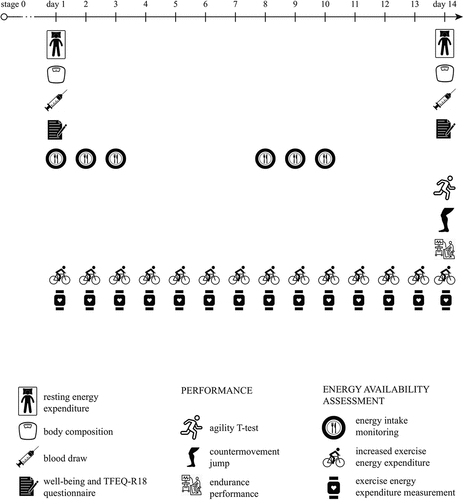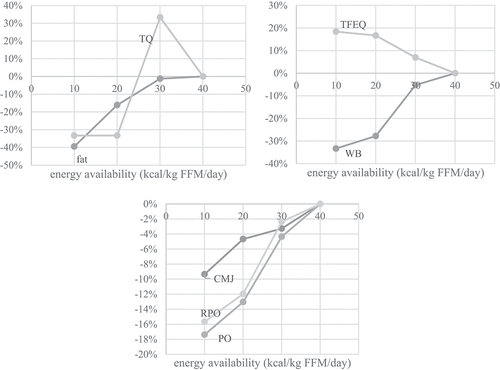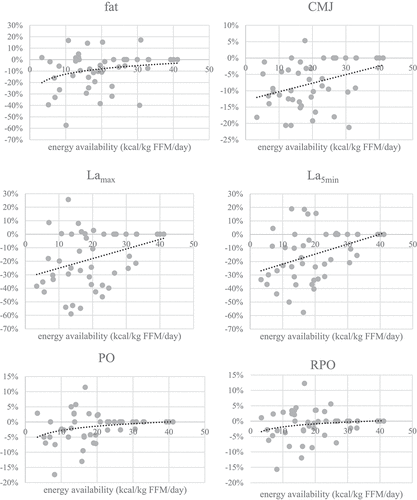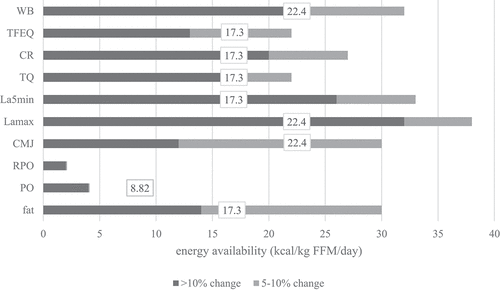Figures & data
Figure 1. Stages 1-3 had the same 14-day timeline: measurements of health, REE and well-being were performed at the beginning and the end of each stage. In addition, three sport-specific performance tests were performed at the end of the stages.

Table 1. Summary of the main findings in three-stage EA reduction phases
Figure 2. Effects of reduced EA on body fat % (fat) and testosterone quartile reference range (TQ, top left), on mental state as assessed by the Three Factor Eating Questionnaire (TFEQ-R18) and Well-being questionnaire (WB, top right) and on performance as measured by the countermovement jump (CMJ), relative power output (RPO) and power output (PO, bottom) in a representative athlete. The differences are expressed in percent relative to values acquired before the intervention.

Figure 3. Changes of anthropometric, performance, psychological and blood parameters at different EA values. All changes are expressed relative to values before the intervention in percent (fat=body fat percent, CMJ=countermovement jump, PO=power output, RPO=relative power output, Lamax=lactate concentration at the end of the incremental test, La5min=lactate concentration 5 minutes after the end ofthe incremental test, WB=well-being questionnaire, TFEQ-R18=the Three Factor Eating Questionnaire,TQ=testosterone reference range quartile).

Figure 3. Changes of anthropometric, performance, psychological and blood parameters at different EA values. All changes are expressed relative to values before the intervention in percent (fat=body fat percent, CMJ=countermovement jump, PO=power output, RPO=relative power output, Lamax=lactate concentration at the end of the incremental test, La5min=lactate concentration 5 minutes after the end ofthe incremental test, WB=well-being questionnaire, TFEQ-R18=the Three Factor Eating Questionnaire,TQ=testosterone reference range quartile).

Figure 4. Mean EA values when differences in measured parameters were >10% (black), 5-10%(grey) and mean EA value when T-test firstly showed a significant difference in parameter after EA reduction (number in white square). Determining the threshold for LEA in men is most probably a spectre between observed parameters as LEA affects health, performance and mental state and all parameters are not affected at the same EA absolute value. Also, there are clearly individual differences in resilience to reduced EA in 14 days. This chart suggests the spectre could be between 2and 32 (when mean difference is >10%), with mean value of 17 kcal·kg∙FFM·d-1. In the stage 2 (EA=17.3±5.0 kcal·kg∙FFM·d-1) we also observed statistically poorer values in the most of the observed parameters (fat=body fat percent, CMJ=countermovement jump, PO=power output, RPO=relativepower output, Lamax=lactate concentration at the end of the incremental test, La5min=lactate concentration 5 minutes after the end of the incremental test, WB=well-being questionnaire, TFEQR18=the Three Factor Eating Questionnaire, TQ=testosterone reference range quartile).

